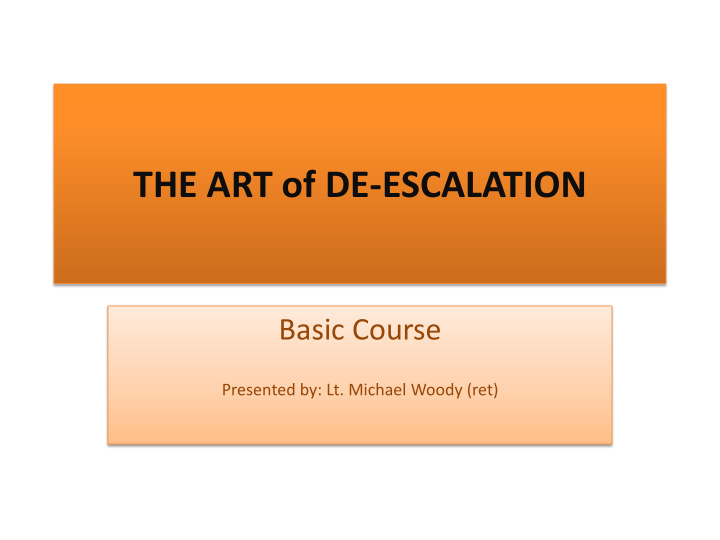



THE ART of DE-ESCALATION Basic Course Presented by: Lt. Michael Woody (ret)
DE-INSTITUTIONALIZATION
AMERICAN IDOL
American Idol
ANOSIGNOSIA • Research shows that persons with a severe mental illness often are unaware of their illness! • So… • No matter how hard you try to convince them otherwise, they are not going to believe you!
• Most studies find that about one half of the people with serious mental illness don’t take their medication. • The most common reason is poor insight into illness . • Dr. Xavier Amador
• We know today, right now, that building a respectful and trusting relationship is the key to helping someone with poor insight accept treatment for mental illness! Dr. Xavier Amador – from his book “I Am Not Sick, I Don’t Need Help!” 2 nd edition.
George Thompson Ph.D.’s 5 Universal Truths • 1. People want to be RESPECTED (unconditionally) • 2. They want to be ASKED – not told • 3. They want to be told WHY • 4. They want to be given OPTIONS (not threats) • 5. People want SECOND CHANCES
ACTIVE LISTENING “We were given two ears but only one mouth. This is because God knew that listening was twice as hard as talking.” - Unknown
IS HE LISTENING?
WHAT IS ACTIVE LISTENING? Active listening is a communication skill which involves both the speaker and the receiver.
ACTIVE LISTENING Listen with only one goal: To understand the other person’s point of view and reflect your understanding back to him
ACTIVE LISTENING TECHNIQUES • ENCOURAGING • RESTATING • REFLECTING • SUMMARIZING
ACTIVE LISTENING HUMAN BEINGS WANT TO EXPRESS THEMSELVES, TO BE HEARD. - When emotion is directed at you, hearing the speaker out diffuses the emotion. - If a speaker feels they are not being heard, they may be compelled to act. ACTIVE LISTENING IS A POWERFUL DE-ESCALATION TOOL.
It is the wise officer who can at times, conceal their combat-ready status!
BODY LANGUAGE BODY LANGUAGE
October 2004 Session
Empathy What is it & why is it important
Empathy: What is it? • Empathy = accurate statement of another person’s experience • - Don’t need to have the experience • - Don’t judge or evaluate it
Empathy: Why is it Important? • Conveys understanding • Others feel understood & supported • Encourages others to share more • Creates a connection • Establishes rapport • - That then enables problem-solving, advice, etc.
Empathy • It communicates to the person that you understand their feelings. • - “Seeing things through another’s eyes” • - ”Putting yourself in someone else’s shoes”
How to be empathic: • 1. Careful listening (to their experience) • 2. Deciding upon accurate feeling words • 3. Communicating understanding to the person
1. Careful Listening • Pay attention! • Encourage the talker to continue. Nod and say, “mmm”; Don’t interrupt • Focus on the other person’s experience.
2 . Deciding on Accurate Feeling Words • What is this person feeling? What “feeling words” did they use? • Putting yourself in their shoes • Keep in mind: people often feel two ways.. Happy, hopeful, grouchy, silly, sad, depressed, mad, etc.
3. Communicating Understanding • Simple, short phrases • “Interested” tone • Slow • At times tentative… • Use empathic stems
Empathic stems • “Maybe you feel ….” • “Sounds like a _______ day” • “What a day you’ve had” • “That is a lot to deal with” • “That is the last thing you wanted” • “That’s confusing when that happens” • “It’s hard for you to know what to do…” • “ Right now it feels like there is no hope” • “You wish things were different” • Nod and say, “mmm”
More empathic stems • “From your point of view…” • “Let me see if I understand you…” • “I wonder if…” • “I can appreciate how you might…”
CONNECT then DIRECT
Being Unempathic: The Don’ts • Don’t criticize • Don’t give advice • Don’t try to solve it • Don’t analyze it • Don’t align yourself with “the other side”
Remember… CONNECT then DIRECT
My Ten Commandments 1. Your safety comes first. 2. Keep therapeutic spacing 3. Speak in tones that fit the situation 4. When appropriate use non- threatening posture
5. Personalize the conversation (use first names, look for people places or things in common 6. Ask how you can help them? 7. Don’t be afraid to set firm but calm limits
8. Never lie to get the person to comply 9. Don’t internalize the consumer’s (EDP’s) negative comments 10. Never forget that schizophrenia, bipolar disorder, and major depression are organic and genetic disorders. The consumer did nothing to inherit them. So… There by the grace of God, go I.
More helpful hints Always remember that you are having contact with the consumer (EDP) generally at their worst. When they are med compliant they will be more lucid and will remember what you said and how you treated them. This will help in future interventions.
REMEMBER Wherever these techniques are used across the country by law enforcement & correction officers – Injuries and death go down!
Unless you’re like this guy! October 2004 Session
2005 National Crisis Intervention Team Officer of the Year
Recommend
More recommend